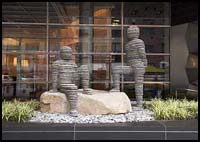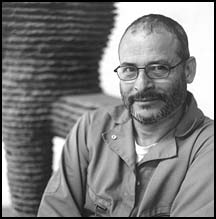|
 In the Spring of 2004, a sculpture by Williamsburg artist Boaz Vaadia was installed on the south side of Manhattan's new Time Warner Center. A monumental piece called "Asaf and Yo'ah" of a couple, one seated on a boulder, one standing, occupy a space at the entrance to the residential building of the complex. In the Spring of 2004, a sculpture by Williamsburg artist Boaz Vaadia was installed on the south side of Manhattan's new Time Warner Center. A monumental piece called "Asaf and Yo'ah" of a couple, one seated on a boulder, one standing, occupy a space at the entrance to the residential building of the complex.
No serious artist in mid-career changes styles lightly. When Boaz Vaadia turned away from a successful, but struggling existence as an abstract sculptor to follow a powerful urge to recreate a figurative artistic vision he had been struck by, his artist friends thought he was crazy.
Until 1984, Boaz Vaadia was working abstractly, exhibiting in regular gallery shows at 100 Acres Gallery in Soho and constructing large scale site works on Wards Island, Battery Park, Bear Mountain and in Israel, Like most young artists he struggled to make a living and worked at construction jobs on the side. The process of tearing down and building inherent in these jobs has had a profound influence on his method of working, and in his choice of media both before and after his career changing watershed.
Vaadia built his sculptures using cast off materials he found in dumpsters and construction sites in downtown Manhattan: slabs of bluestone removed from New York City sidewalks, curb stones, window sills, cobble stones, mammoth support beams. These became his signature art materials. He was drawn to the fact that they came from the earth intrinsically unaltered, and that they came from man's urban habitat as well.
Although abstract, Vaadia's early work deals with man's relation to nature and the earth. Some works resembled certain elements of human habitats: a bridge, a cairn or primitive architecture supporting an abstract personage (a vertical form, perhaps a proxy for a human form).
 He continually seeks to tap into and transmit the energy of nature, through his art, to the viewer. Powerful forces shaped the earth and and stone which is Vaadia's chosen material. Later, man took these stones and shaped them into a supportive environment. Vaadia senses an accumulation of energy in these ancient things and this energy fuels his art. In a 1981 essay the artist stated, "My work is trying to awaken these ancient 'Earth Senses' that were slowly abandoned by man during his long evolution through civilization.... My works create an environment that is a votive offering to the connection between the spirit of a human being and nature." He continually seeks to tap into and transmit the energy of nature, through his art, to the viewer. Powerful forces shaped the earth and and stone which is Vaadia's chosen material. Later, man took these stones and shaped them into a supportive environment. Vaadia senses an accumulation of energy in these ancient things and this energy fuels his art. In a 1981 essay the artist stated, "My work is trying to awaken these ancient 'Earth Senses' that were slowly abandoned by man during his long evolution through civilization.... My works create an environment that is a votive offering to the connection between the spirit of a human being and nature."
In addition to stone, Vaadia used wood posts, the slender but strong cedar stakes often seen in New York City supporting and protecting the young trees planted along sidewalks.
Spare, with no extraneous detail, these structures Vaadia created in the late '70s seem designed to serve a specific function. Whether the function is informational, ceremonial, or utilitarian, the viewer cannot know. Wall pieces from the same period in which wood stakes lashed with leather support heavy slabs of bluestone, call to mind the way ip which written text is displayed in temples and churches. A piece of stone, to Vaadia, may be as much of a container of energy and historical information as the Talmud or the Bible.
Vaadia's work changed shortly after he moved to a new studio, leaving an upper story loft for a ground floor industrial garage space on Williamsburg's Berry St. At that time the streets were torn up as con- struction workers rebuilt the sewer system. As they dug they removed boulders which had been in the ground since the ice age. Vaadia, when he saw them, wanted them. The crews said he could have them if he removed them himself.
Soon after purchasing a fork lift, Vaadia had a studio full of boulders. Sometime later, on a rainy day, Vaadia invited his new friends, the construction workers, to come inside his space, to eat their lunch away from the weather. When they came in, each man made himself comfortable in relation to a bolder in a different way. One sat on top of a boulder, another sat on the ground leaning against a boulder, and so forth. According to Vaadia, "When I saw them, I said to myself, this is it."
The sight of the workers arranged on and about the boulders, gave him a template for a series of sculptures, a metaphor for the relationship between man and the earth. It felt right to him. Before he did anything else, he told himself, he was going to make sculptures which would relate to the boul- ders the same way the workmen had. At that moment he turned away from abstraction and has not looked back.
Using the same bluestone he had favored in his abstract work, Vaadia devised a way of creating a figure by piling up flat rounded shapes precisely cut by chipping with hammer and chisel. He depends on gravity to hold these pieces in place as he works. The resulting figures are evocative of ancient figurative sculpture, and ancient pictograms.
He builds his figures one contour at a time, accumulating a form from a number of unique but similar parts. In a way, these parts resemble the cross sections we are by now accustomed to hearing about in medical procedures such as the CAT scan or MRI. In spite of the lack of descriptive detail, the figures exude a benign warmth, and a peaceful energy. In a way, they resemble outsider art, emerging from a well of experience the artist is able to tap into that is common to us all.
Vaadia's decision to follow his artistic desire proved wise. In 1986 he had his first figurative show at OK Harris Gallery in Soho. The entire show sold out in 3 hours. OK Harris owner Ivan Karp said he never saw anything like that in his entire life. Today his monumental figures are in art collections throughout the world. In New York City his work is at the Metropolitan Museum and in three outdoor collections including the Time Warner Center. In addition to Time Warner Center, Vaadia's works can be seen outdoors at 200 East 94th Street, between 3rd and Lexington facing 93rd Street, and at All Souls Church between 79th and 80th streets.
_____________________________
|